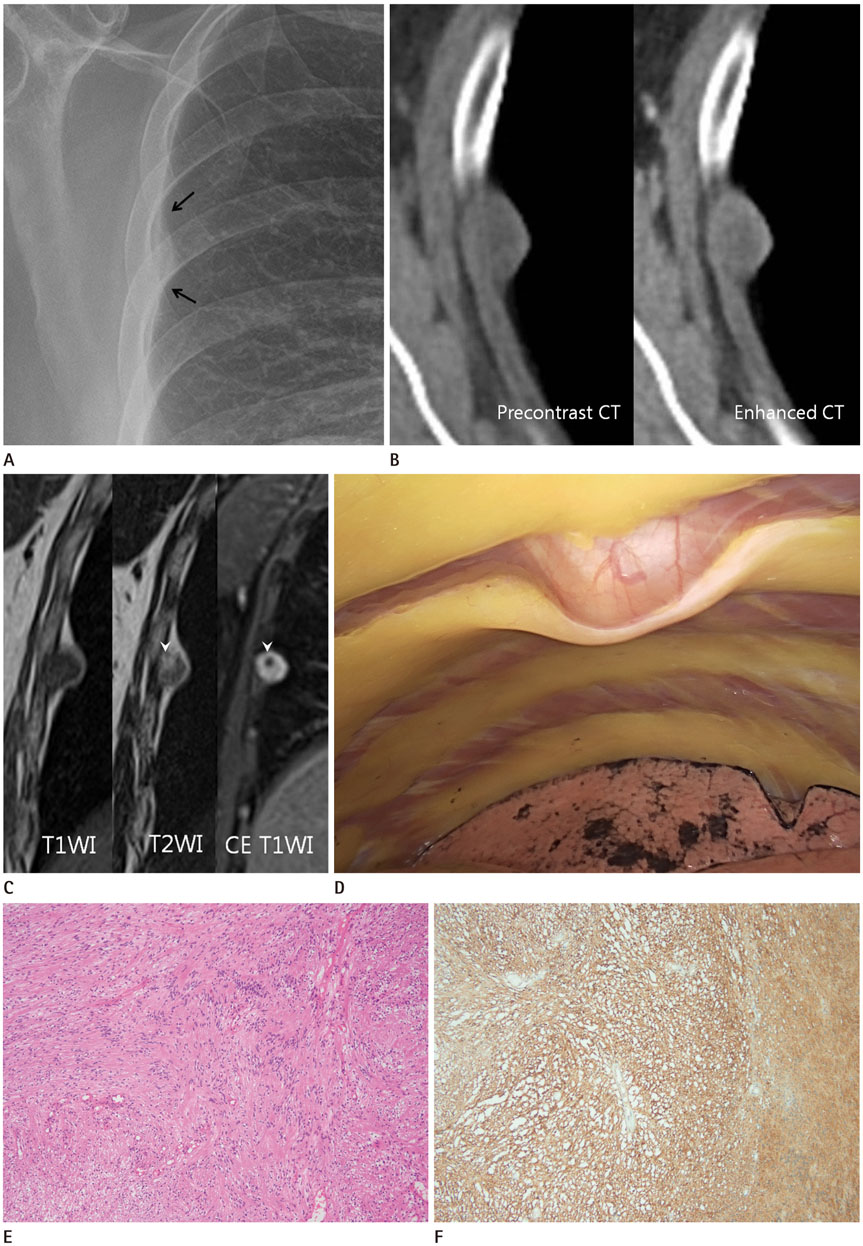J Korean Soc Radiol.
2018 Aug;79(2):63-67. 10.3348/jksr.2018.79.2.63.
MRI Findings of Intercostal Schwannoma: A Case Report
- Affiliations
-
- 1Department of Radiology, Kangnam Sacred Heart Hospital, Hallym University College of Medicine, Seoul, Korea. younglady@hallym.or.kr
- 2Department of Pathology, Kangnam Sacred Heart Hospital, Hallym University College of Medicine, Seoul, Korea.
- KMID: 2416390
- DOI: http://doi.org/10.3348/jksr.2018.79.2.63
Abstract
- Intercostal schwannomas are uncommon, encapsulated neoplasms that originate in nerve sheaths of intercostal nerves. They account for less than 10% of primary neural tumors of the chest wall. Herein, we report a pathologically confirmed case of intercostal schwannoma with typical magnetic resonance imaging findings.
Figure
Reference
-
1. Meyer C, Rodepeter F, Bartsch D, Kirschbaum A. Intercostal neurinoma: a rare cause of persistent thoracic pain. Thorac Cardiovasc Surg Rep. 2014; 3:48–50.
Article2. Tateishi U, Gladish GW, Kusumoto M, Hasegawa T, Yokoyama R, Tsuchiya R, et al. Chest wall tumors: radiologic findings and pathologic correlation: part 2. malignant tumors. Radiographics. 2003; 23:1491–1150.3. McClenathan JH, Bloom RJ. Peripheral tumors of the intercostal nerves. Ann Thorac Surg. 2004; 78:713–714.
Article4. Nam SJ, Kim S, Lim BJ, Yoon CS, Kim TH, Suh JS, et al. Imaging of primary chest wall tumors with radiologic-pathologic correlation. Radiographics. 2011; 31:749–770.
Article5. Pavlus JD, Carter BW, Tolley MD, Keung ES, Khorashadi L, Lichtenberger JP 3rd. Imaging of thoracic neurogenic tumors. AJR Am J Roentgenol. 2016; 207:552–561.
Article6. Hwang ST, Sung DJ, Sim KC, Han NY, Park BJ, Kim MJ, et al. Radiologic findings of renal schwannoma: a case report and literature review. J Korean Soc Radiol. 2018; 78:289–294.
Article7. Nakazono T, White CS, Yamasaki F, Yamaguchi K, Egashira R, Irie H, et al. MRI findings of mediastinal neurogenic tumors. AJR Am J Roentgenol. 2011; 197:W643–W652.
Article8. Lin J, Martel W. Cross-sectional imaging of peripheral nerve sheath tumors: characteristic signs on CT, MR imaging, and sonography. AJR Am J Roentgenol. 2001; 176:75–82.9. Takanashi Y, Urabe N. [Schwannoma of the chest wall showing a bead-like appearance;report of a case]. Kyobu Geka. 2013; 66:1027–1029.10. Kim KS, Ji SR, Kim HM, Kwon YJ, Hwang JH, Lee SY. Intercostal nerve schwannoma encountered during a rib-latissimus dorsi osteomyocutaneous flap operation. Arch Plast Surg. 2015; 42:800–802.
Article
- Full Text Links
- Actions
-
Cited
- CITED
-
- Close
- Share
- Similar articles
-
- Refractory intercostal neuralgia due to intercostal schwannoma: A case report
- Hypervascular Vestibular Schwannoma: A Case Report
- Benign Schwannoma Mimicking Metastatic Lesion on F-18 FDG PET/CT in Differentiated Thyroid Cancer
- Diagnostic Value of MRI in Schwannoma
- Spinal Intradural Schwannoma with Torsion: A Case Report


